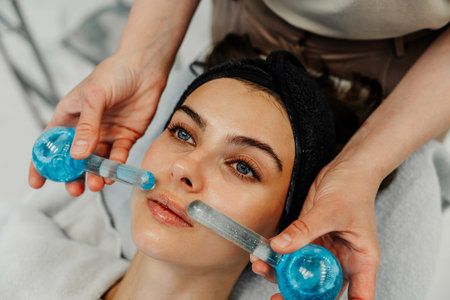Understanding Skin Health Post-Treatment
Following a non-surgical facial procedure, such as dermal fillers, chemical peels, or laser resurfacing, the skin undergoes a unique recovery phase that is crucial to achieving optimal results. Immediately after treatment, your skin may appear slightly red, sensitive, or swollen—this is a normal response as your body initiates the natural healing process. During this period, the skin’s barrier function can become temporarily compromised, making it more susceptible to environmental stressors and dehydration. It is essential to support your skin’s health at this stage by adopting gentle aftercare routines tailored to enhance hydration and encourage recovery. Understanding how your skin reacts post-treatment empowers you to make informed choices about skincare products and daily habits, ensuring long-lasting benefits from your chosen procedure. Prioritising skin health not only aids in quicker recovery but also helps maintain the glowing, refreshed appearance that non-surgical facial treatments are designed to deliver.
2. Immediate Aftercare Steps
After undergoing non-surgical facial treatments, such as dermal fillers, chemical peels, or microneedling, it is essential to follow immediate aftercare instructions to support optimal skin health and hydration. Adhering to UK skincare standards not only minimises irritation but also ensures the best possible outcome from your treatment. Below are detailed recommendations for your post-treatment care.
Cleansing Routine
It is advised to cleanse your face gently with lukewarm water and a mild, fragrance-free cleanser. Avoid using hot water or harsh exfoliants for at least 48 hours post-procedure. Gently pat the skin dry with a clean towel instead of rubbing, which could cause further sensitivity.
Recommended Cleansing Steps
| Step | Description | UK-Approved Advice |
|---|---|---|
| 1. Initial Rinse | Use lukewarm water to splash the face lightly. | Avoid extremes in temperature to prevent redness. |
| 2. Gentle Cleanse | Apply a pea-sized amount of gentle cleanser. | Select SLS-free and fragrance-free formulas. |
| 3. Pat Dry | Pat face dry with a soft, clean towel. | Avoid rough or abrasive towels. |
What to Avoid Immediately After Treatment
- No Touching: Refrain from touching, picking, or scratching the treated area to reduce infection risk.
- No Makeup: Avoid applying makeup for at least 24 hours unless specified by your practitioner.
- Avoid Heat Exposure: Stay away from saunas, steam rooms, and direct sunlight for at least 48 hours.
- No Intense Exercise: Postpone vigorous exercise that may cause sweating and irritation for 24-48 hours.
- No Alcohol or Smoking: Both can impair healing and increase the risk of complications.
Minimising Irritation and Promoting Hydration
To soothe post-treatment sensitivity, use cool compresses if needed but do not apply ice directly onto the skin. Opt for hydrating serums containing hyaluronic acid, which align with UK standards for sensitive post-procedure skin. It is advisable to avoid retinol, acids (like AHA/BHA), and perfumed products until your practitioner confirms their safety for reintroduction.
Summary Table: Immediate Dos and Donts According to UK Skincare Standards
| Do | Dont |
|---|---|
| Use gentle cleansers and pat dry Apply recommended hydrating serums Follow all practitioner advice strictly Wear broad-spectrum SPF if outdoors |
Avoid makeup for 24 hours No touching or picking Skip hot baths/saunas Avoid active skincare ingredients (retinol/acids) |
The first 48 hours after a non-surgical facial treatment are critical for recovery and results. Following these immediate aftercare steps tailored to UK skincare protocols will help maintain your skin’s health, enhance hydration, and minimise any unwanted reactions.

3. Hydration Strategies for Recovery
Maintaining optimal hydration is fundamental to successful recovery following non-surgical facial treatments such as chemical peels, microneedling, or laser therapy. Ensuring that your skin retains adequate moisture not only accelerates the healing process but also helps minimise irritation and enhances overall results.
Optimal Hydration Practices
During the recovery phase, it is crucial to support your skin’s natural barrier function. Begin by selecting a gentle, hydrating cleanser—avoid harsh surfactants and opt for products containing soothing ingredients like oat extract or chamomile. After cleansing, apply a fragrance-free moisturiser rich in ceramides or hyaluronic acid to reinforce skin hydration without causing further sensitivity. Drinking sufficient water throughout the day is equally important; aim for at least 1.5 to 2 litres daily, as this supports both internal and external hydration.
Choosing British Skincare Products
The UK offers a wealth of high-quality skincare brands renowned for their focus on sensitive skin and post-procedure care. Look for products from trusted names such as ELEMIS, REN Clean Skincare, or Liz Earle, which often feature naturally derived hydrators suitable for compromised skin. Additionally, consider using serums or creams containing squalane or rosehip oil—both popular in British skincare routines—to lock in moisture and encourage gentle repair.
The Significance of Moisture Balance
Preserving your skin’s moisture balance during healing cannot be overstated. Overly dry skin can become tight, flaky, and prone to prolonged redness, while excessive occlusion may lead to breakouts or congestion. Use lightweight formulas initially and adjust based on your skin’s response. Avoid hot showers and central heating where possible, as these can further dehydrate the complexion. Adopting these hydration strategies ensures your skin remains resilient and recovers gracefully, leaving you with a healthy, radiant glow post-treatment.
4. Sun Protection and Environmental Factors
While the UK may not be renowned for its sunshine, protecting your skin from ultraviolet (UV) exposure is an essential step in aftercare following non-surgical facial treatments. Even on overcast or drizzly days, UV rays penetrate cloud cover and can compromise your results or trigger sensitivity, redness, and pigmentation. It’s important to integrate broad-spectrum sun protection into your daily skincare routine immediately after treatment. Below is a quick reference guide to effective sun protection measures in the UK climate:
| Protection Method | Recommended Practice |
|---|---|
| SPF Application | Apply a broad-spectrum SPF 30 or higher every morning; reapply if outdoors for extended periods. |
| Physical Barriers | Wear wide-brimmed hats and sunglasses when out and about, even on cloudy days. |
| Sunscreen Type | Choose mineral-based sunscreens for sensitive or recently treated skin. |
Shielding Against Everyday Environmental Stressors
Beyond UV exposure, environmental factors such as wind, pollution, and fluctuating temperatures in the UK can also affect your post-treatment skin health. These elements can exacerbate dryness, irritation, and compromise the delicate healing process. Consider these practical aftercare tips:
- Wind Protection: Use scarves or hoods to shield your face during blustery weather.
- Pollution Defence: Incorporate antioxidant serums (like vitamin C) to combat free radical damage caused by urban pollution.
- Hydration Maintenance: Use a gentle, hydrating moisturiser to support the skin barrier against cold or dry air.
Key Takeaway
Regardless of the season or weather conditions typical in the UK, maintaining diligent sun protection and safeguarding against environmental aggressors are fundamental steps to optimise recovery and prolong the benefits of your non-surgical facial treatment.
5. Ongoing Skin Maintenance
Maintaining healthy, hydrated skin after non-surgical facial treatments requires a consistent and well-considered skincare routine. In the UK, where the climate can be unpredictable—often swinging between damp, chilly winters and warmer, sunnier summers—it’s especially important to adapt your regimen to both the season and your individual skin needs. Long-term skincare starts with the basics: gentle cleansing, daily moisturising, and regular application of broad-spectrum SPF, even on overcast days. Incorporating hydrating serums containing hyaluronic acid or glycerin can help lock in moisture, while antioxidants such as vitamin C support skin resilience and brightness.
Professional advice from a British skincare expert or aesthetician is invaluable for tailoring your routine. Regular check-ins—every three to six months—allow your regimen to be adjusted according to how your skin responds to treatments and seasonal changes. These experts can also recommend suitable products that are both effective and readily available within the UK market, ensuring compatibility with your skin type and lifestyle.
In terms of ongoing professional treatments, many clients benefit from scheduling non-surgical facials, hydrating boosters, or gentle peels every four to eight weeks, depending on individual goals and skin sensitivity. British clinics often advocate a personalised approach, taking into account not only your skin’s appearance but also your daily habits and environmental exposures. By combining at-home care with periodic professional treatments, you can maintain a radiant complexion and support long-lasting hydration throughout the year.
6. Recognising and Responding to Complications
While non-surgical facial treatments are generally safe and well-tolerated, it is important to remain vigilant for any signs of complications. Prompt recognition and appropriate response can prevent minor issues from escalating and safeguard your skin health. Here’s what you need to know in the UK context.
Identifying Common Signs of Adverse Reactions
After non-surgical procedures such as dermal fillers, chemical peels, or laser treatments, mild redness, slight swelling, or tenderness are expected and usually subside within a few days. However, you should be aware of warning signs that may indicate a more serious reaction:
- Persistent or worsening redness, swelling, or pain beyond 72 hours
- Unusual bruising or discolouration (such as blanching or a dusky blue tone)
- Development of lumps, nodules, or firmness under the skin
- Signs of infection (increased warmth, yellow or green discharge, fever)
- Allergic reactions (itching, hives, difficulty breathing)
When to Consult Local Professionals
If you experience any of the above symptoms or if something feels unusual after your treatment, it is essential to seek advice from your practitioner promptly. In the UK, reputable clinics provide clear aftercare instructions and an emergency contact number. If your symptoms are severe—such as intense pain, rapid swelling, or visual disturbances—contact NHS 111 or visit your nearest A&E department for immediate evaluation.
Recommended Protocols for Managing Concerns
- Document Your Symptoms: Take photos and note any changes in your skin’s appearance to share with your practitioner.
- Contact Your Clinic: Most UK clinics offer follow-up appointments and support. Reach out as soon as you notice an issue; early intervention is key.
- Avoid Self-Treatment: Refrain from applying over-the-counter remedies unless specifically advised by a medical professional.
- Follow Professional Advice: Your practitioner may recommend specific creams, oral medication, or referral to a specialist if needed.
Patient Safety and UK Standards
The UK has robust regulations governing non-surgical cosmetic procedures. Choose practitioners registered with bodies such as the General Medical Council (GMC), Nursing and Midwifery Council (NMC), or Joint Council for Cosmetic Practitioners (JCCP) to ensure high standards of care. Always verify credentials before treatment and keep records of your procedures for reference.
By staying informed and responsive, you play an active role in protecting your skin health and hydration after non-surgical facial treatments. If ever in doubt about your recovery process, do not hesitate to consult local healthcare professionals who are familiar with UK protocols and best practices.

